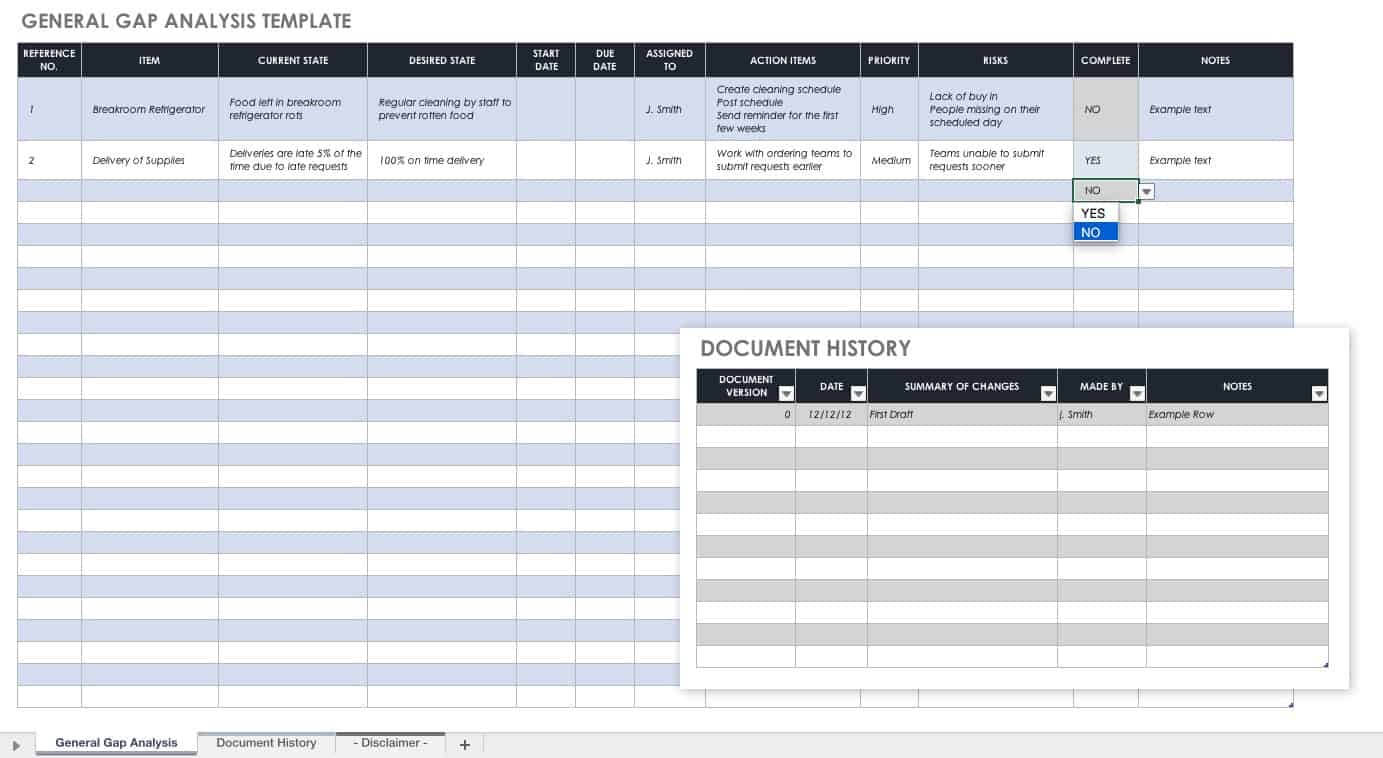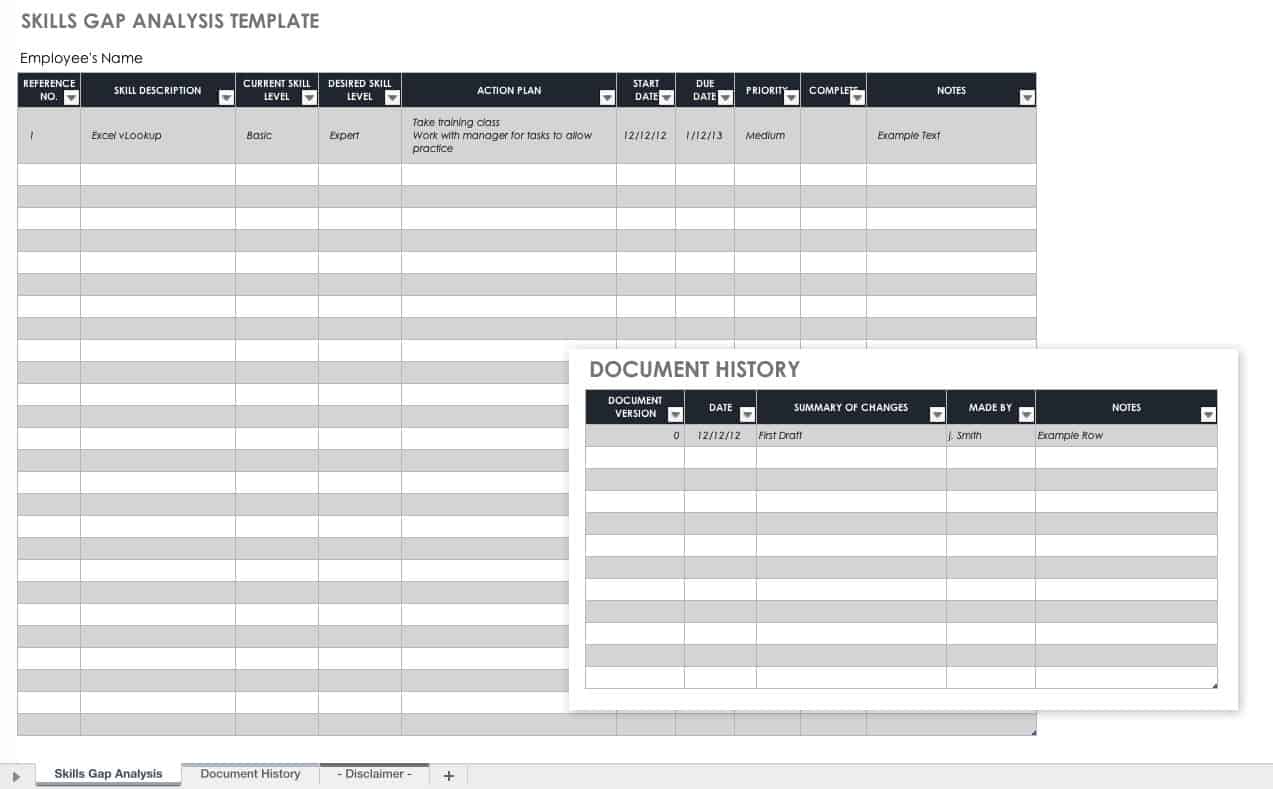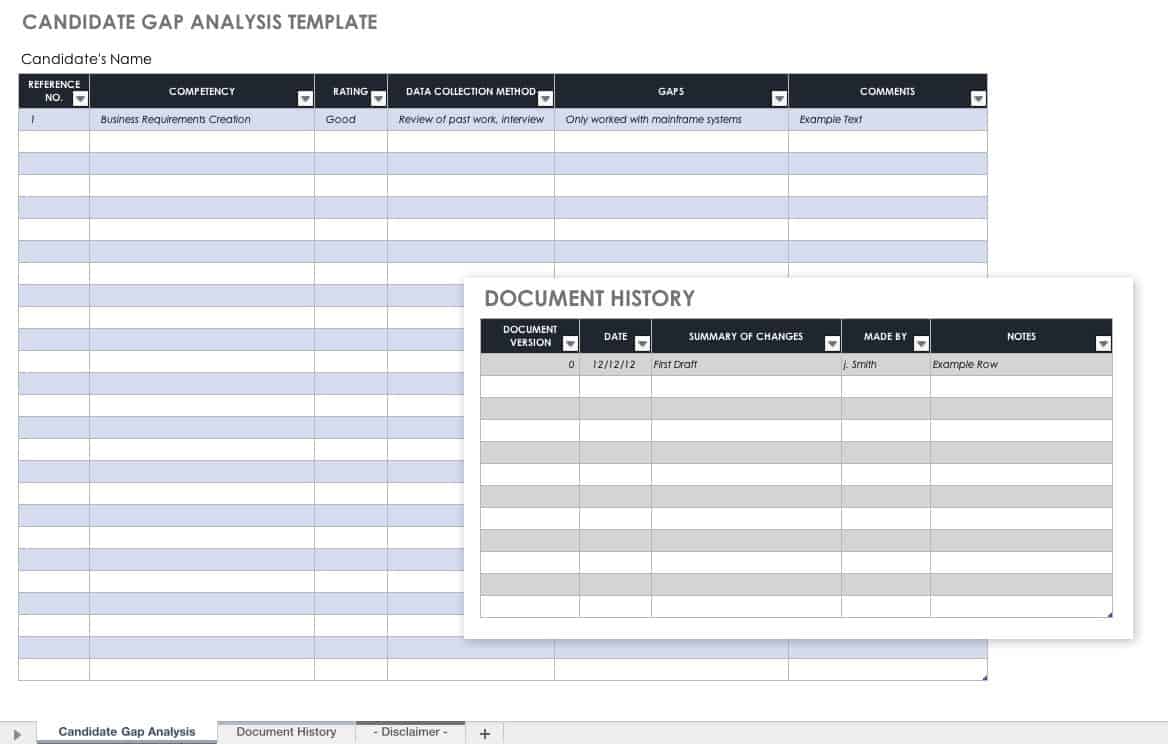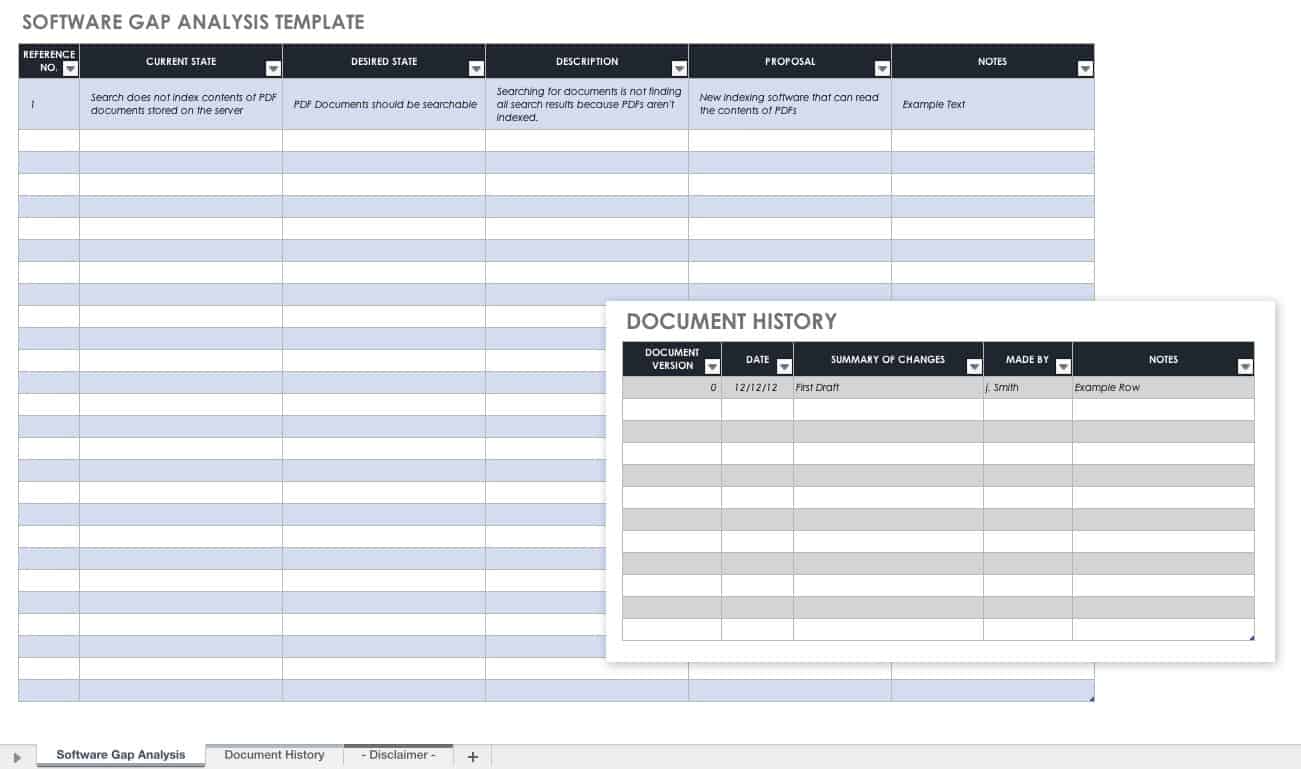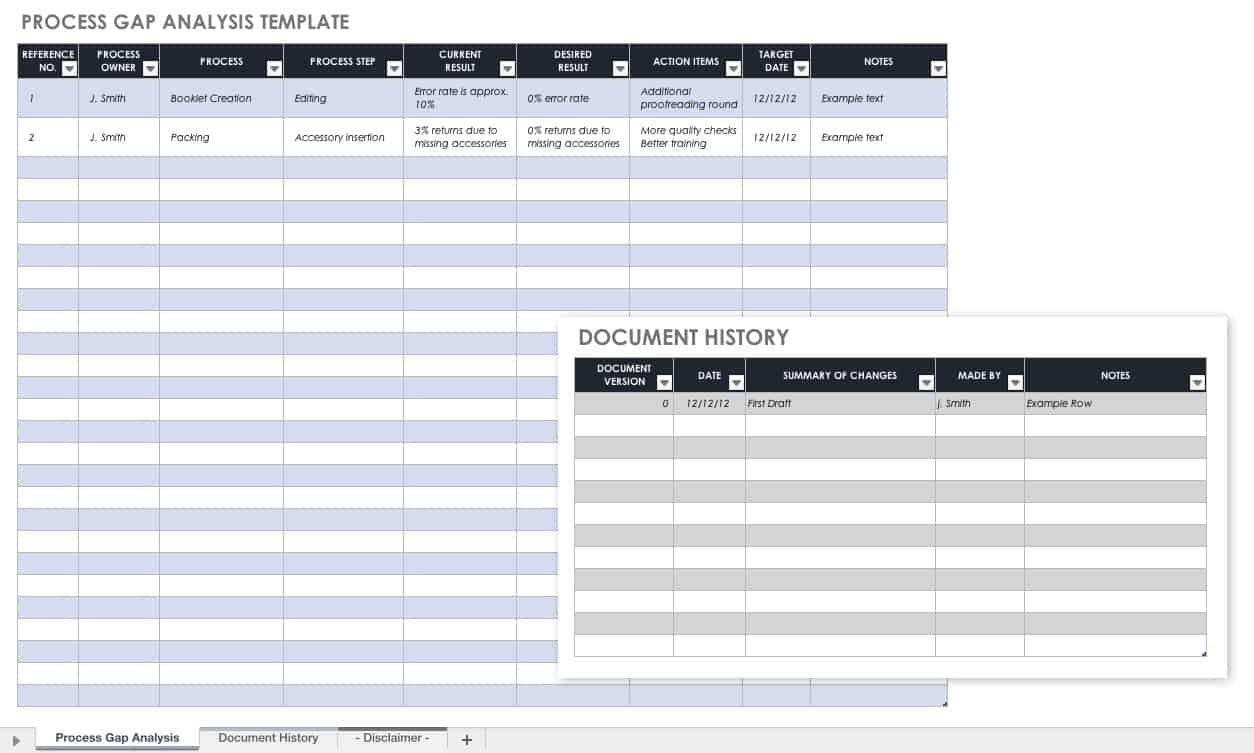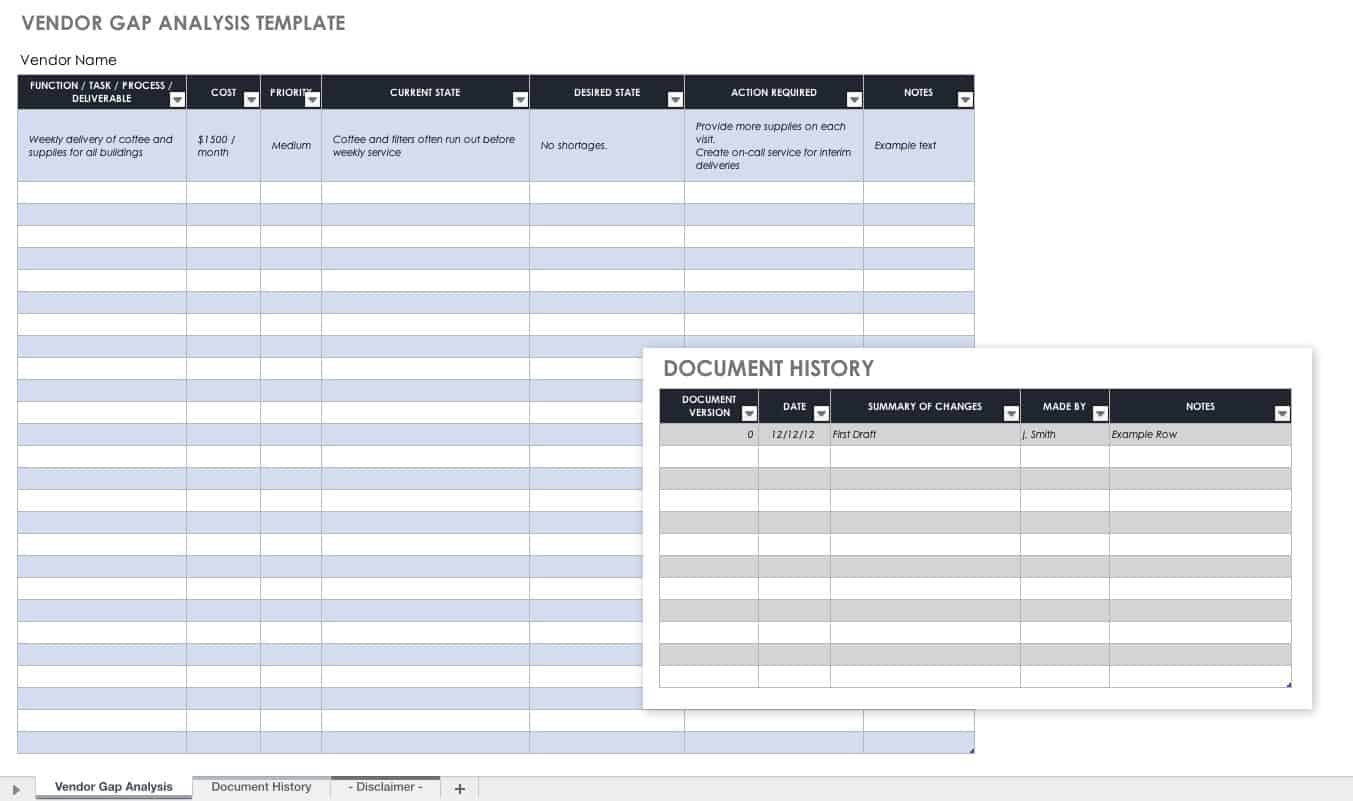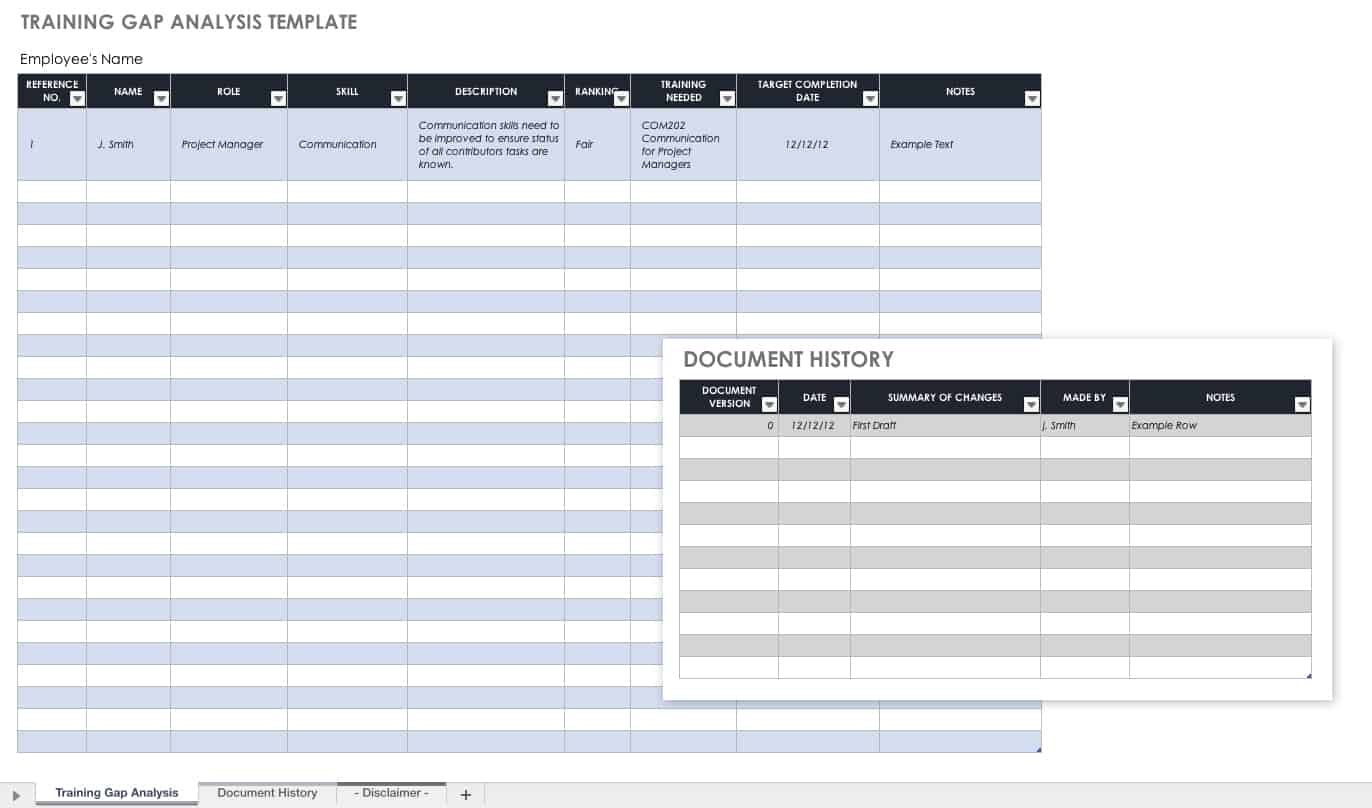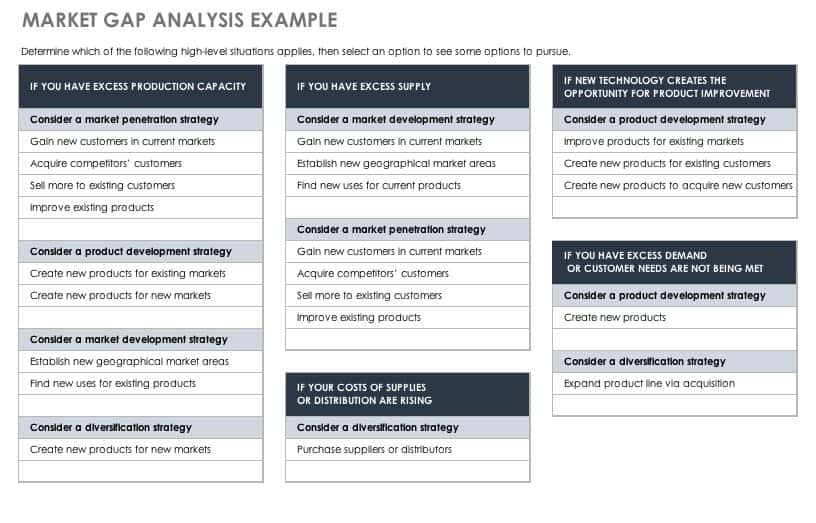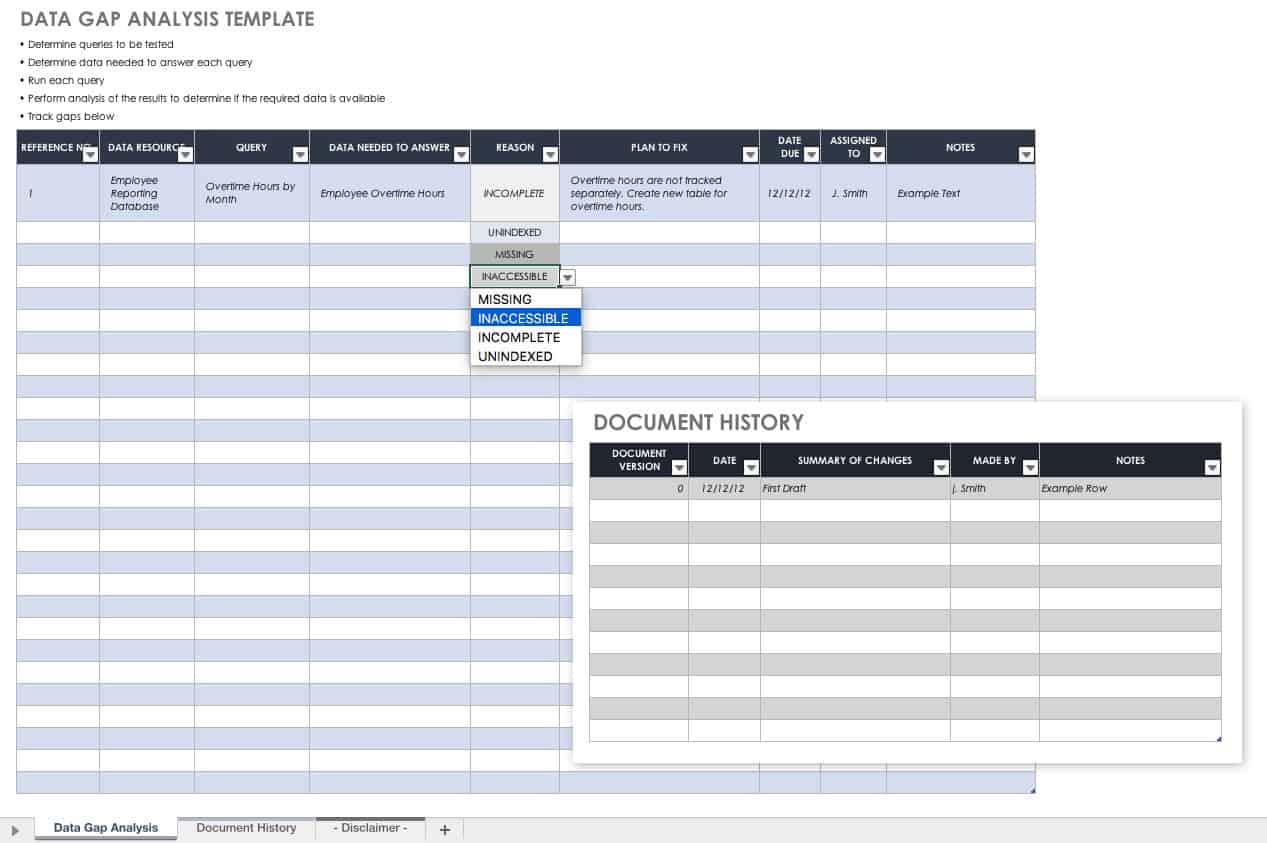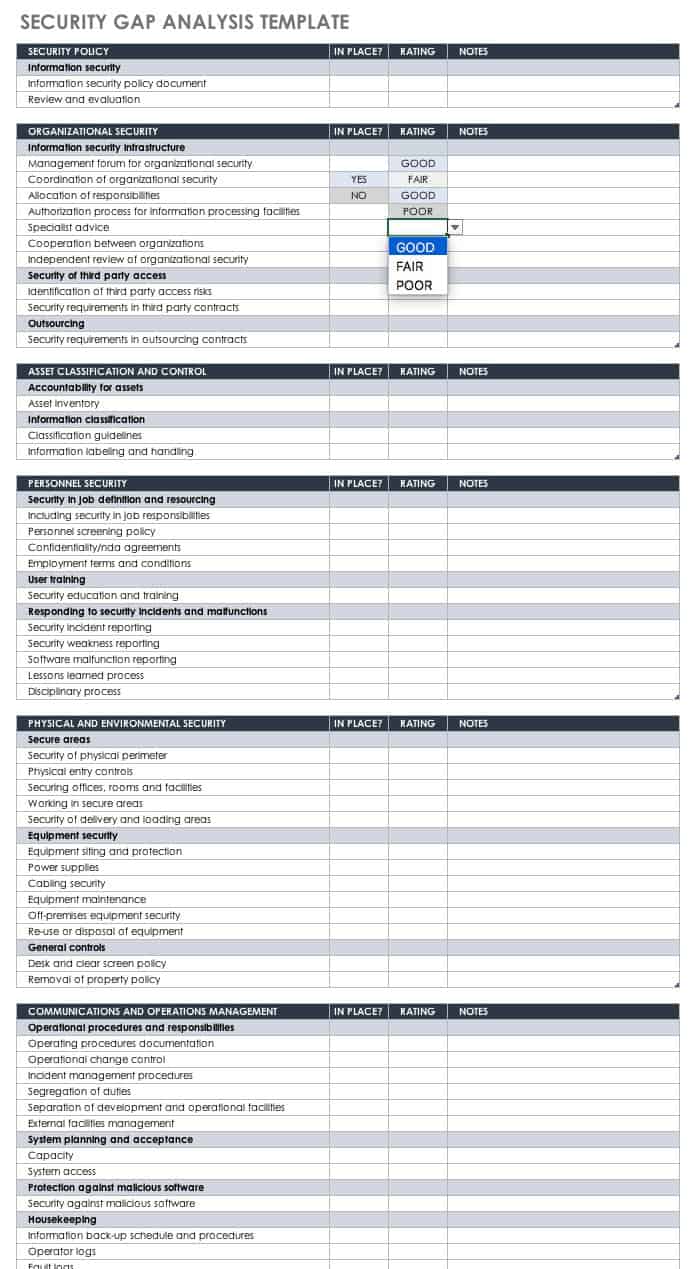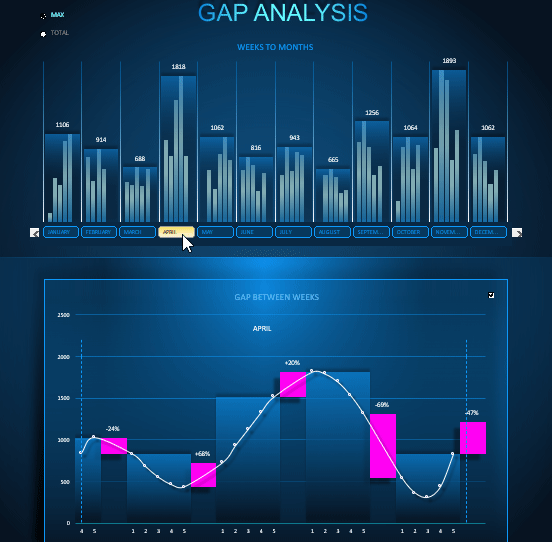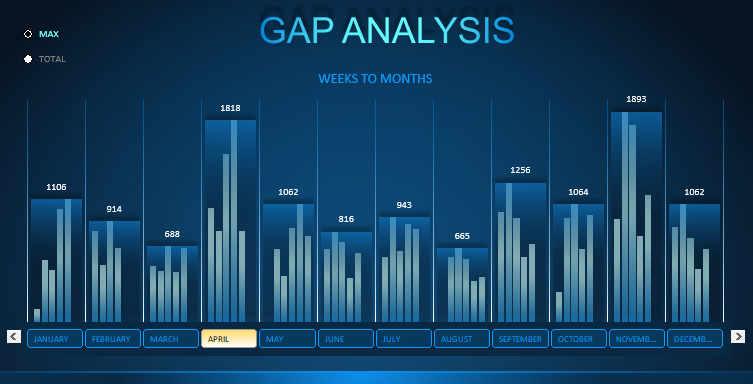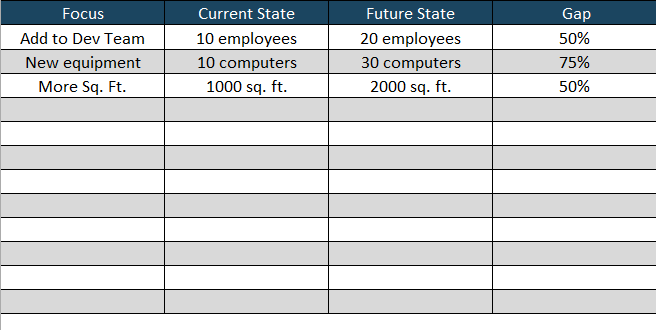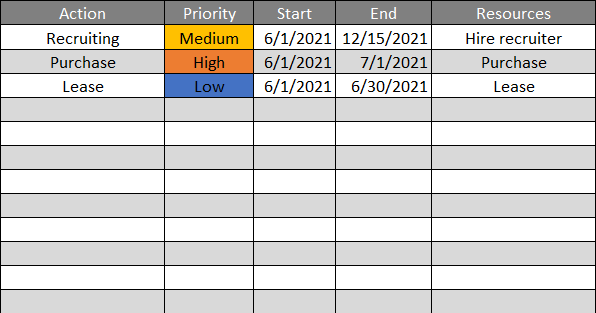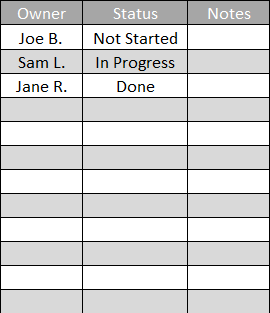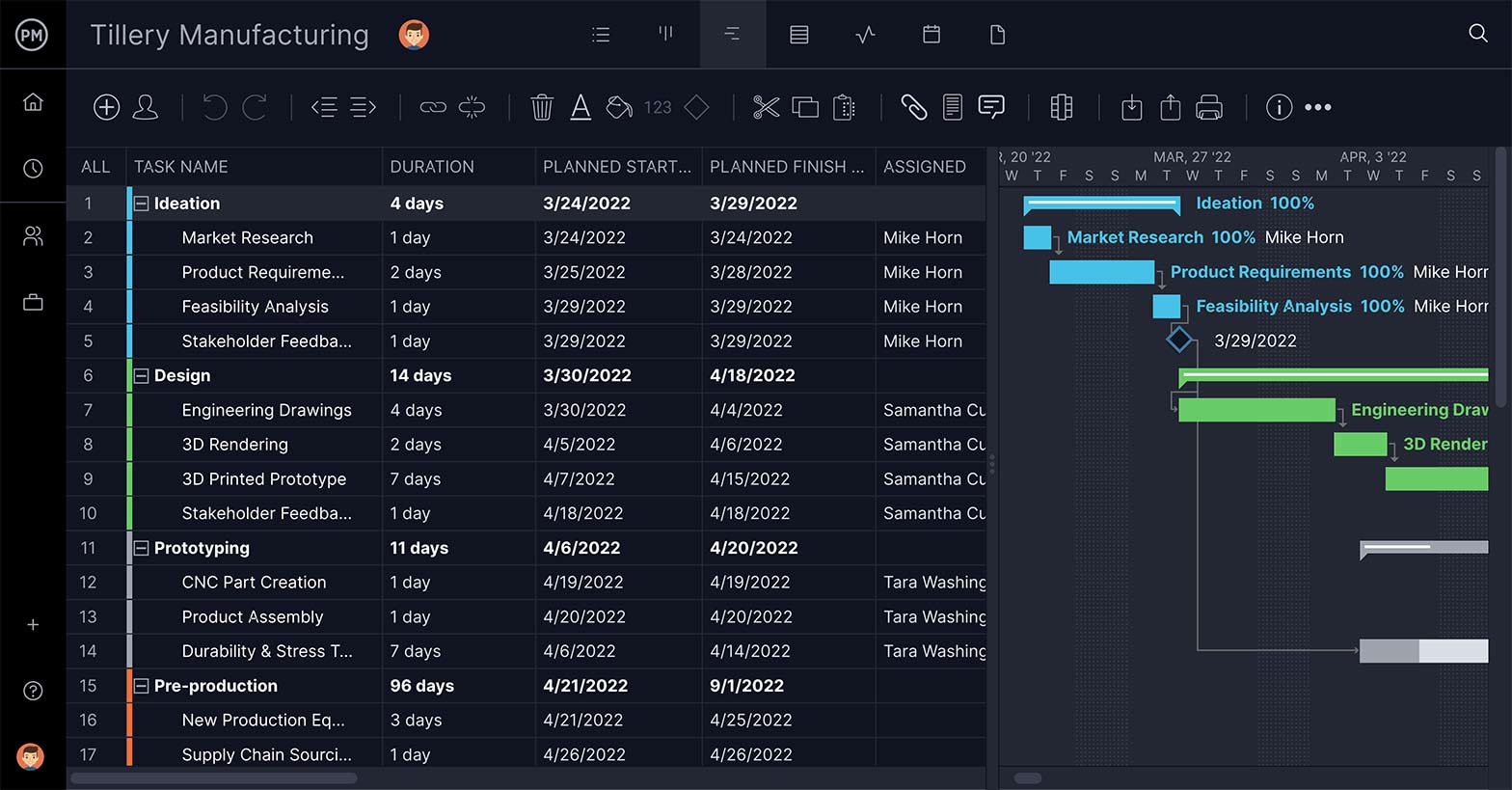You can use the gap analysis templates below to document what you discover and the changes you need to make.
General Gap Analysis Template
Adapt this general gap analysis template to many situations, such as reviewing regulatory compliance or a cost benefit analysis. If a specific template for your needs isn’t available, or you aren’t sure where to start, use this template to find where gaps exist and guide the process of narrowing or eliminating them.
Download General Gap Analysis Template
Skills Gap Analysis Template
A skills gap analysis template guides an employee through updating their skills so that they are better qualified to receive promotions or improve their performance. The template provides spaces to list the skills, level of proficiency, and desired outcome. You’ll also find an area to create an action plan for the employee along with start and end dates.
Download Skills Gap Analysis Template
Candidate Gap Analysis Template
A candidate gap analysis template is an ideal choice to evaluate the skills of a person applying for a posting. The results of the gap will help you determine if the applicant would be a good addition to your organization. This template also includes space where you can rate the applicant’s competency, note existing gaps, and add comments.
Download Candidate Gap Analysis Template
Software Gap Template
A software gap template is useful for evaluating software that you’re considering purchasing (to see if will meet the company’s needs), or to assess existing software (to determine if it needs to be replaced). There is space to document the desired state, description of the need, and the proposed solution.
Download Software Gap Template
Process Gap Analysis Template
Use this process gap analysis template to consider existing processes and find out where they fall short, and to plan for how to improve or update the process. This template includes an area to describe the process, note the process owner, and state the current and desired results. Use action items and target date areas to start developing a plan to make improvements.
Download Process Gap Analysis Template
Vendor Gap Analysis Template
The vendor gap analysis template can help guide the selection of a new vendor or to evaluate the performance of an existing vendor. In this template, you’ll find an area for identifying your need, cost, and priority.
Download Vendor Gap Analysis Template
Training Gap Analysis Template
Perform a training gap analysis to determine which required and optional training courses employees need to complete in order to meet objectives. Complete the areas for role, skill, description, ranking, and training needed for each employee. Use the target completion date to formulate a plan to ensure that team members get the support they need.
Download Training Gap Analysis Template
Market Gap Analysis Template
Use a market gap analysis to discover new sales opportunities, areas where supply is not meeting demand, or areas for diversification. This method is based on the Ansoff Matrix technique. After you learn a general status, this template can direct a business toward possible high-level improvement options.
Download Market Gap Analysis Template
Excel | PDF
Data Gap Analysis Template
Perform a data gap analysis to find out what data is not available to answer queries that a user may pose, and to begin the process of making the data available. Use the template fields for data resource, query, data needed to answer, and reason to get an overview of the state of your data. Complete the plan to fix, due dates, and assigned sections to start to act on the results of the analysis.
Download Data Gap Analysis Template
Security Gap Analysis Template
The security gap analysis template can help track weakness in security policies, protocols, or documentation that help drive improvements. The template is divided into sections and can be used in whole or in part.
Download Security Gap Analysis Template
На чтение 7 мин Просмотров 23.6к.
Одним из инструментов консалтинга является метод стратегического анализа, который называется GAP анализом. При помощи его путем сопоставления запланированных задач с полученными результатами выясняют, чего не хватило для достижения заданной цели.
Содержание
- Что представляет собой GAP-анализ
- Особенности GAP-анализа
- Этапы проведения GAP-анализа
- Преимущества GAP-анализа
- Недостатки GAP-анализа
- Области применения GAP-анализа
- Пример проведения GAP-анализа
Что представляет собой GAP-анализ
Методика GAP-анализа разработана достаточно давно в Стэндфордском университете (США). На сегодня ее активно применяют в разных сферах деятельности, но особенно в стратегическом менеджменте. В экономике можно встретить другое название этого термина: «анализ разрывов» или попросту «метод стратегического анализа». Что примечательно: в переводе с английского слово «GAP» означает «разрыв», «пробел».
GAP-анализа связана – исключительная методика, позволяющая соизмерить желаемые, поставленные цели с достигнутыми в реальности. Далеко не всегда компании удается осуществить желаемый результат, задуманный при планировании, даже несмотря на продуманность, тщательность просчетов и подготовки. При помощи GAP-анализа:
- Определяют величину, причину отклонений, т. е. разрывов между тем, что было запланировано, и тем, что получилось.
- С учетом выявленных отклонений и возможностей компании корректируют стратегическую цель, а также деятельность в целом.
- Разрабатывают мероприятия для того, чтобы минимизировать, устранить данные разрывы с наименьшими затратами и потерями.
Методика необходима для того, чтобы устранить разрывы, добиться желаемого либо, по крайней мере, максимально приблизиться к запланированному результату. Используя GAP-анализ, компания сможет понять, что произойдет, если она не внесет коррективы, чтобы исправить отклонения.
Важно! GAP-анализ применяют только при наличии отклонений, выявленных между запланированными и достигнутыми целями.
При данном анализе используют сведения из первичного плана, текущие, достигнутые показатели. Между тем анализ может показать отсутствие каких-либо отклонений. Это говорит об эффективной работе компании. Тогда ничего предпринимать по устранению разрывов не требуется.
Особенности GAP-анализа
Применяя GAP-анализ, изучают конкретную ситуацию, которая может быть связана не только с протекающими бизнес-процессами и особенностями менеджмента, но и:
- качеством товара;
- непосредственно с обслуживанием (customer service);
- рынками сбыта, их особенностями, категорией потребителя.
Так, к примеру, в центре внимания (исследования) чаще всего оказываются:
- Эффективность коммуникаций. Оценке подлежат уровень, выгодность, качество взаимодействий. В результате этого выявляют несоответствие по части отношений между компанией и потребителями, поставщиками, контрагентами.
- Потребности, желания, запросы покупателей, определяемые через сопоставление действительности и ожиданий. Обычно все это связывают с качеством товара, при изучении которого попутно рассматривают пожелания и требования клиентов. Затем определяют что нужно сделать компании, чтобы довести качество товаров до требуемого, и удержать имеющихся покупателей, а также привлечь новых.
- Имидж (image), образ компании. Речь идет о сравнении впечатления, которое компания, по сути, вместе со своими сотрудниками, производит на других людей (покупателей, контрагентов, проч.). Т. е. как рынок воспринимают компанию и ее товары, имидж компании и конкурентов и др.
- Результаты продаж: сопоставление плановых и фактических значений показателей на конкретный, текущий момент. При этом во внимание принимают мнение, как производителя, так и покупателя.
- Сопоставление итоговых значений показателей компании с запланированными.
Таким образом, GAP-анализ целиком построен на сопоставлении, которое позволяет выявить несоответствия и понять, что компания сделала не так, как нужно скорректировать ее действия.
Этапы проведения GAP-анализа
Анализ от самого его начала и до конца должен проводить компетентный специалист. Сам процесс предполагает прохождение нескольких этапов:
- Постановка цели анализа, определение области, которую нужно исследовать. На этом этапе собирают исходные сведения о тех либо иных проблемах для последующего исследования. Например, требуется изучить продажи, чтобы выяснить, как их увеличить, а также как повысить резервы для роста прибыли.
- Изучение реальной ситуации, т. е. того, что есть на данный момент. Анализу подлежат текущие значения показателей и факторы, влияющие на ситуацию, которая анализируется.
- Анализ запланированных в самом начале целей: чего планировали достигнуть, каковы плановые значения показателей в настоящий момент.
- Выявление отклонений (разрывов) между плановыми и текущими значениями показателей, а также их причин, характера.
- Составление плана реагирования (схемы действий) для устранения выявленных отклонений. Ориентировочный (предполагаемый) прогноз по данным мероприятиям.
Общая схема действий такова: определение разрыва – установление, анализ первопричин – разработка плана мероприятий по улучшению. В процессе анализа допускается использование графических приемов: построение графиков, диаграмм, прочих графических моделей. Таким способом сопоставляют сложившуюся ситуацию, отображают отклонения, возможности компании. Делают это не по каким-то общим правилам, их как таковых нет. Руководствуются при этом наглядностью, главное, чтобы была четко отображена и понятна суть вопроса, а также выявленные отклонения.
Преимущества GAP-анализа
Несомненными достоинствами анализа разрывов являются:
- простота, скорость проведения (нужно сопоставить то, что хотели, запланировали, с тем, что получили);
- универсальность (подходит для любой компании, а также для использования обычными гражданами в повседневной жизни);
- результативный эффект анализа (при помощи его компания оперативно оценивает проблемную ситуацию, свои возможности, разрабатывает план для решения проблемы, минимизируя затраты).
Недостатки GAP-анализа
Минусов у GAP-анализа всего два, но они достаточно ощутимы:
- Прибегая к такому анализу, можно оценить и выявить лишь явные отклонения. На самом же деле на выявленный разрыв может влиять множество разных факторов. Не исключено, что степень их влияния выявить при этом будет практически невозможно. Именно из-за этого, порой, сложно устранить разрывы полностью либо уменьшить их до требуемого уровня.
- Анализ позволяет скорректировать только ситуацию, связанную с появившимися отклонениями. В результате все же можно добиться желаемой цели, но переделать, изменить плановые показатели, пересмотреть первоначальные планы уже нельзя. Альтернативные решения в подобных случаях не приемлемы, поскольку их прогнозы чаще всего недостоверны.
Области применения GAP-анализа
Из сказанного выше можно сделать вывод, что GAP-анализ применяют практически везде, где есть временной интервал и нужно получить результаты. Т. е. где имеется настоящая и запланированная ситуация, которую можно сопоставить.
Взять, к примеру, образование. Через проведение опросов можно собрать информацию для того, чтобы выявить и проанализировать разрыв между тем, что студенты хотят получить от вуза и что получают по факту. В стратегическом планировании типичным примером могут служить следующие сопоставимые ситуации:
- Предельно допустимый, возможный уровень спроса и наличествующее предложение компании. Путем сопоставления этих двух ситуаций можно выявить реальный разрыв между ними.
- Аналогично, посредством GAP-анализа, определяют отклонения между лучшими отраслевыми и текущими показателями компании.
Данный инструмент часто используют предприятия в хозяйственной деятельности, в т. ч. при оценке степени готовности предприятия к внедрению СЭМ (стандарта ISO 14000). GAP-анализ подлежит применению в сфере услуг (качество сервиса), торговле, а также политике, отчасти в медицине и даже спорте.
Пример проведения GAP-анализа
Предположим, нужно проанализировать ситуацию, связанную с повышением тарифов оператора сотовой связи и качеством сервиса. В центре внимания: тарифы с услугами и требования, пожелания клиентов. Применяя GAP-анализ, нужно:
- Охарактеризовать текущее состояние компании, в каком состоянии пребывают ее ресурсы.
- Определить отклонения. В рассматриваемой ситуации отклонением является недовольство клиентов услугами связи, высокими тарифами.
- Разработать план реагирования для устранения выявленных отклонений.
Все сведения по проведенному GAP-анализу систематизированы и кратко приведены далее в таблице.
| Какие отклонения выявлены | Что нужно сделать
(ключевые задачи) |
План реагирования
(основные мероприятия) |
|
клиенты жалуются на повышенные тарифные планы |
снизить тарифы |
модернизация оборудования;
сокращение затрат компании; разработка новых, более доступных, дешевых тарифных планов; снижение тарифа на услуги худшего качества, повышение цен только на качественные услуги |
|
клиенты недовольны обслуживанием |
улучшить клиентский сервис |
изучение конъюнктуры рынка, а также текущих потребностей клиентов путем проведения опросов;
проведение внутреннего аудита; разнообразие услуг, установка дополнительного оборудования |
Example of interactive use of data visualization in Excel for presentation and analysis of price gaps between weekly periods. You can download the template at the end of the article. But first familiarize yourself with its principles of operation and use.
Visual analysis of gaps in statistical data on the Excel chart
Financial and economic indicators never move in a linear line. More often than not, the dynamics of changes in their values resembles a roller coaster. Analyzing visual reports on charts, one can observe their statistical movement down, up, slow, fast — always in different ways. Moreover, in contrast to the roller coaster, the value curves on the visualization can contain discontinuities for various reasons. Examples of discontinuities of statistical values on the financial chart of the stock price:
- Gap up — the price of the minimum is higher than the price of the maximum of the previous day.
- Gap down — the price of the maximum is lower than the price of the minimum of the previous day.
In this example, this time we will present several situation models at once for applying the template with data visualization. Immediately 4 models of the situation necessary in the gap analysis of statistical values for the accounting period.
Model 1 stock market chunks break up after the weekend
The investment portfolio contains most of the high-yield stocks with high volatility that are listed on the New York Stock Exchange. But there is a small nuance. The New York Stock Exchange is only open Monday through Friday, and it is closed on the weekend. Nevertheless, most public companies that list their stocks on the NYSE are open on weekends and continue to try to improve their financial and economic performance on those days. Plus the various financial events in the world have no days off and take place whether it’s Saturday, Sunday or any other day. And many of the favorable and unfavorable events that occur on weekends have a significant impact on stock prices and securities. The most volatile securities, such as silver futures, are particularly affected. As a result, it is clear to the naked eye in the visualization of the stock price how much different Friday is from Monday. Price gaps of 10%-15% and sometimes even more are not uncommon.
It is necessary to analyze whether there were stock price gaps after the weekend and between what weeks? If so, how significant were they? All in order to determine the factors influencing the rate and their power to control the profitability of the investment portfolio.
Model 2 weekly gaps trading strategy in the forex market
The forex market in most cases has price gaps between weeks at the boundaries of Friday and Monday. Almost every new week begins with a price gap on the chart of the rate of one or another currency pair. The reason is the very nature of the global currency market. The largest international currency market in the world is the FOREX. It operates around the clock in four trading sessions at different times, which overlap each other:
- Pacific session.
- Asian.
- European.
- American.
Forex market works 24 hours a day, every working day of the week except weekends. On weekends the Forex currency exchanges and the market in general are closed, that is 24/5. Along with them, central banks around the world are closed for 2 full days off. And so it is every week. But no one has canceled the interbank market, which continues to work actively on weekends, i.e. 24/7. On Monday, all central banks and the most global Forex market open, and the situation with currency prices has already changed for two whole days. As a result, there is a price gap between Friday’s close and Monday’s open. Especially large gaps between weeks for very volatile currency pairs, such as GBP/JPY.
The interbank market is much smaller than all central banks and the global Forex market. Therefore, in most cases, these gaps are false and are closed by the force of a fair price. As a result, the price returns to its proper level in the first days of the week. Many traders build very effective trading strategies on this fact. But sometimes the factor influencing the gap could not be the interbank market, but an important economic event, which led to a panic of market participants. Therefore, you need to assess the risks correctly and place orders with the correct Stop Loss and Take Profit orders at the proper levels.
It is necessary to analyze how false and essential is the price gap. And also on what levels of the prices it is better to expose orders Stop Loss and Take Profit for orders on purchase or sale.
Model 3 Cash Gaps
Some businesses do not conduct financial activity on weekends for a variety of reasons: market specifics, a special category of clients (e.g., government agencies), company policy (e.g., some banks do not operate on weekends). As a result, there may be small cash gaps and under-receipt of planned revenues. Or a series of unforeseen cash gaps may unfairly underestimate the sales plan.
It is necessary to determine between which weeks in a month cash gaps are most likely to be expected in order to make fair sales plans.
Model 4 Strategic Gaps
Any long-term financial goal is unattainable without short-term budgets. The financial analyst has no right to rely on random luck, but only facts and strategy! In essence, a strategy is a decomposition of sequential, logical and objectively realizable objectives. That is, when planning a strategy, the global goal is divided into smaller goals, objectives and subtasks. If the sequence is broken, there is a risk of strategy failure on the way to achieving the global goal. The place where the sequence has been disrupted is called the strategic gap. A professional analyst must have the art of planning based on his projections! In practice, no strategy is implemented without strategic gaps, as all sorts of circumstances occur and make adjustments to the short-term plans of the global strategy.
It is necessary to identify strategic gaps and assess the strength of their impact on the medium-term goals and objectives in order to eliminate them in the next stages of achieving the goal. After all, a mistake is just a chance to try again with a new level of experience.
Data visualization structure
You can use the data visualization tools in Excel to work with the analysis of statistical data gaps between weekly periods. This interactive template consists of two visualization blocks and a control panel.
The upper block displays the overall picture for the selected accounting period of 1 year:
Each bar on the histogram shows the values for the month, formed from a group of columns of values for a weekly period. That is, there are 5-6 weeks in each month (4-5 weeks in February). In the upper left corner there is a switch between displaying the total values for the month:
- MAX — the week with the maximum value in the current month.
- TOTAL — the sum of all week values for the current month.
Below the block is a control panel of twelve buttons for switching between months on the lower block. And two buttons on the edges for scrolling the lower block for easy visual analysis of the weekly gaps located at the borders between the end and beginning of months.
The bottom block has only one control to turn on and off the display of pink blocks at the gaps:
The size of the pink break block visually displays its approximate size. And above the block the price displacement at the gap in percent is indicated. If the gap is down, the value is negative with a (-) sign, and if it is up, it is positive with a (+) sign.
Using the arrow buttons for scrolling, you can scroll through the chart on the lower visualization block, and the vertical dashed line indicates the end/beginning month boundary:

Fill in your raw data on the «Data» sheet in the first two columns of the range A3:B367. The cells in this range are highlighted with a border, a black line. The other cells on this sheet are filled with formulas. This template contains no macros and is free to use. It is easy to modify it to suit your specific tasks and needs.
Identify new opportunities to attract new visitors through organic search
How will the gap analysis template help me and my business?
An SEO gap analysis helps you review your «market share of consumer searches».
Use our gap analysis spreadsheet to identify opportunities to attract new high quality visitors searching on high intent keywords online. It compares the effectiveness of organic search compared to paid in driving visitors to your site.
When consulting with businesses, we have found that many have a poor target keyword list which is either not detailed enough or poorly structured. This spreadsheet will show you how to create a comprehensive target keyword report and review your performance to help you identify new SEO and content marketing strategies. At Smart Insights, we use this spreadsheet as part of our SEO strategy and it helps us deliver over 80% of the half a million unique visits we get per month to our website, generated through organic search.
What is gap analysis?
Where there’s a high demand for products or searches (as indicated by the number of searches/search terms used), but you have a relatively low share of visits to your site from natural search, you can identify this as a ‘gap’ that you can work to ‘fill’ through SEO optimization. To do this, you’ll need to understand and review the best SEO techniques to increase visits. For support with this, we have a dedicated SEO Learning Path which teaches you how to use a data-driven approach to improving your SEO strategies.
What does the SEO gap analysis template include?
SEOs who work regularly on keyword analysis will likely have their own Google Docs or spreadsheet for this. We created this spreadsheet to save members’ time and to help you explore data in greater depth than is possible in Google Analytics since it uses fairly advanced Excel VLOOKUP() functions to search for keywords across a list, and a conditional wildcard SUMIF() function which occasional Excel users may not be familiar with. If you are unfamiliar with these techniques, we include information on them in our SEO gap analysis spreadsheet.
Who is this template for?
We’ve used this SEO gap analysis approach on many search marketing consultancy projects in financial services, retail, and travel sectors. It’s a great way to review areas where your SEO performance is poor and see how you can tap into new opportunities.
Our keywords template will let you review the keyword strategy for your business or your clients. It’s designed to be practical and actionable – it will help identify ‘quick wins’ to boost traffic, and help you build a stronger keyword strategy for consistently better SEO results.
This template is aimed at:
- Marketing, e-commerce and digital marketing managers who need to understand and improve their keyword strategy and review the key issues to discuss with their in-house team, agencies or consultants.
- Agencies and consultants who use it to review their client’s current keyword positions and identify areas to improve.
- Smaller businesses who use our guide as a “do-it-yourself” template to boost their business’ SEO and develop a more effective keyword strategy.
Resource Details
- Author: Dr. Dave Chaffey
- Format: Excel (.xls) template
About the author
Dr. Dave Chaffey
Dave is co-founder and content director of Smart Insights. He is editor of the 100+ templates, ebooks and courses in the digital marketing resource library created by our team of 25+ Digital Marketing experts. Our resources used by our premium members in more than 80 countries to Map, Plan and Manage their digital marketing.
For my full profile, or to connect on LinkedIn or other social networks, see the About Dave Chaffey profile page on Smart Insights. Dave is author of 5 bestselling books on digital marketing including Digital Marketing Excellence and Digital Marketing: Strategy, Implementation and Practice. In 2004 he was recognised by the Chartered Institute of Marketing as one of 50 marketing ‘gurus’ worldwide who have helped shape the future of marketing.
Organizations are constantly looking to improve, meet long-term goals and generally stay innovative. One of the tools to strategically analyze where you are, where you want to be and how to get there is called a gap analysis template.
Use our free Excel gap analysis template to develop a rough vision of how your organization can bridge the gap between the current state of affairs and its desired destination. Download our free gap analysis template today and get started.
What Is a Gap Analysis Template?
A gap analysis template is a project management chart that helps you gather the information you need to build an action plan that will take your organization from its current state to the desired future state you want it to be.
That information includes the focus areas of improvement, a gap percentage, a timeline, resource requirements and more. This free gap analysis template for Excel is a great place to get started with your gap analysis.
When Should You Use a Gap Analysis Template?
As noted, the gap analysis template should be used whenever there’s a strategic objective or business goal to hit. It determines the actions necessary to reach that goal. Gap analysis is a very versatile method that can be used for project management, business process improvement and product management. Using a gap analysis template can help you discern why you’re not meeting deadlines in any of those cases.
Gap analysis works best when you have the most accurate picture of your current state. Project management software can help give you more details. ProjectManager is online so you get live data for greater insights. Zero in on where you want to improve with filtered reports on workload, costs and more. Closing the gap is a plan that can be organized on Gantt charts that link dependencies, calculate the critical path and set baselines. Using our real-time dashboards helps you monitor your plan as you put it into action. Get started with ProjectManager for free today.
How to Use ProjectManager’s Gap Analysis Template
Download our free gap analysis template for Excel and get started on meeting those business targets and improving processes. We’ve formatted the gap analysis template for use in a project with space to name the project, project manager and date, but the fully customizable template can be applied to any job that requires a gap analysis.
1. List your focus areas
The first step to using this Excel gap analysis template is to list your focus areas. Those can be, for example, the business processes you seek to improve in your organization, or even an HR skill gap.
2. Determine the current and future state of your focus areas
The next column is the current state of the focus area on which you’re working. Next comes the future or desired state, or where you want to be in the near term. For our gap analysis example, the dev team would like to expand from 10 to 20 employees. Now you have a focus, its current state and the desired state you plan to reach.
3. Estimate the gap percentage
Next, is the gap you need to close which is usually represented by a percentage. Following our gap analysis sample, if the dev team wants to grow from 10 to 20 employees, that’s a 50 percent gap to close. Simply add the percentage under the “gap” column.
4. List action items to close the gap
The next section deals with how you’re going to close that gap. To begin you’re going to need resources. Those could be people, equipment, materials, etc. In our example, it’s contracting with a hiring manager to recruit new dev workers to the existing team.
5. Identify the responsible party
Following this, identify the person in your organization who will be responsible for leading the initiative. They’re tasked with managing whatever action is designed to close the gap between the current and future state.
6. Add notes
Finally, there’s a column in the Excel gap analysis template to note the status of the action. It can be designated as not started, in progress, behind, stalled or done. These can be edited to match your own usage. Then there’s a column to capture any relevant notes that don’t fit in the other columns.
Who Should Use a Gap Analysis Template?
Gap analysis is used in many business settings and who uses them varies depending on where they’re being used. For example, project managers in IT environments will often generate a gap analysis to improve team processes.
When dealing with a business that’s looking to move to the next level, it’s usually the owner who leads any strategic initiative. They will involve relevant employees who can help develop a more accurate picture of the current state of the business. These people will also likely be involved in the action plan.
Software developers also use the gap analysis template. It can help them note the services or other functions that might have been neglected. It also can point to those that need development.
Gap analysis templates are often used in compliance. It helps those responsible for staying in compliance compare requirements to what’s currently being done on the job site or in other areas. There is a number of business professionals who can use the gap analysis template to help them improve and do their jobs better.
Why Should You Use a Gap Analysis Template?
Gap analysis is a way to strategically look at a current state and compare it to the desired state. Organizations can use this gap analysis template for any scenario where they need to move from point A to point B and need to develop an action plan.
Advantages of Using an Excel Gap Analysis Template
This Excel gap analysis template is a basic alternative for those who are new to gap analysis. First, it’s easy to use. Simply list the focus areas, current and future state, action items, priority levels and due dates. That’s all you need to create an action plan.
Another advantage is that most people are familiar with Excel, even though it’s not project management software. And lastly, it’s free to download!
Disadvantages of Using an Excel Gap Analysis Template
A gap analysis template for Excel is just a static document. While it helps you plan, it’s not the right tool to track an action plan. Excel templates are time-consuming as they need to be updated manually. Another issue is that your team might end up with multiple copies of your Excel gap analysis template, which might lead to confusion.
Instead, you should use project management software like ProjectManager. With ProjectManager, you can use Gantt charts and other tools to create visual action plans and collaborate with your team in real time.
ProjectManager & Gap Analysis
Once you have a clear idea of where you are and where you want to go, you need to put that plan into action. ProjectManager organizes your tasks to help you get there faster and for less money by streamlining efficiencies.
Online Gantt charts plot your action from start to finish. It’s easy to add milestones, planned efforts and more. That way, when you start to execute your plan, you can compare the actual effort to your plan and know if you’re falling behind schedule or overspending your budget.
Share reports with stakeholders to keep them updated on progress. In fact, you can share the whole project with them. Managers set the admin rules, so stakeholders can stay in touch with read-only files and your work can’t be mistakenly deleted or changed.
What Other Project Management Templates Can Help with Gap Analysis?
This gap analysis is only one of the dozens of free project management templates we offer for your business. Try as many as you like. We’re sure that they’ll prove helpful and lead you to upgrade to our software. Until that time, here are some other templates you might want to use:
Action Items Template
As you meet with your team to discuss how to move from the current state to the desired one, you can use our free action items template to capture all the ideas in one place. It will help you define who is responsible, what they need to do and when the deadline is.
Project Timeline Template
Once you have your action items defined with deadlines, you’ll want our free project timeline template. Now you can map those tasks across a visual timeline from start to finish. You’ll see the duration for each and know how long it’ll take to reach your desired state.
Work Schedule Template
You have your tasks and they’re on a timeline, now you need to assign the team. Using our free work schedule template will help you organize your resources. Connect the team member to the task and schedule their hours across our weekly planner.
Related Content
While you’re downloading templates, stick around the site. We’re an online hub for all things project management, publishing multiple blogs a week. There are also tutorial videos, guidebooks and more. To get you started, here are a few blogs that speak to the topic we’ve been discussing.
- How to Make a Process Improvement Plan
- Continuous Improvement Business Strategy—A Quick Guide
- How to Implement Business Process Improvement
- How to Perform a SWOT Analysis
- SWOT Analysis Template
- How to Write an Action Plan
- Root Cause Analysis: A Quick Guide
- Strategic Planning in Business
Our gap analysis template is a great tool to move your business forward or improve processes. But to stay competitive, you need software that can handle everything from planning, monitoring and reporting on your performance and progress. ProjectManager is an award-winning tool used by NASA, the Bank of America, Ralph Lauren and more. Tens of thousands of teams work better together with our software. Why don’t you give it a try for free today?

